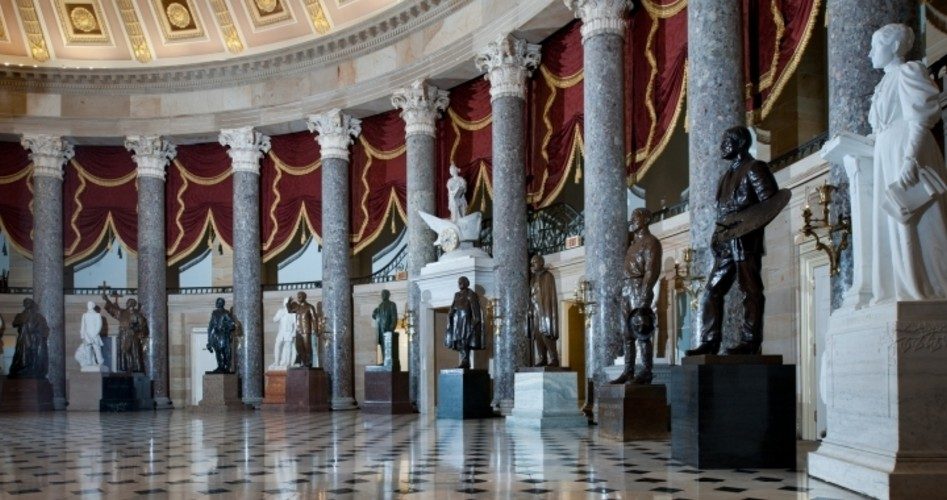
“For those of us who are sons of the South, those of us who have endured hardship, discrimination, and a lot of things that are very difficult to even talk about, for this moment in time where we are today, where we are going to start the process of healing and setting the record straight as it relates to the real history of this country, it is fitting and proper that those individuals who fought to keep many of our ancestors enslaved should not have to be recognized in a place where people who do good expect to be recognized,” said Representative Bennie Thompson (D-Miss.) in arguing for his bill to remove 16 statues that are on display inside the U.S. Capitol, which passed the House of Representatives on Wednesday 305-113.
Every Democrat voted for the bill, which would take away from the states their choice to decide what historical figures from their state should be displayed in the National Statuary Hall Collection (shown). Seventy-two Republicans also voted for the bill, along with former Republican Justin Amash of Michigan, who is now an independent.
Included among those to be removed was the leader of the famed Army of Northern Virginia, Confederate General Robert E. Lee.
“Defenders and purveyors of sedition, slavery, segregation and white supremacy have no place in this temple of liberty,” added House Majority Leader Steny Hoyer (D-Md.).
The bill would not allow a state to choose any statue of any person “who served as an officer or voluntarily with the Confederate States of America or of the military forces or government of a state while the state was in rebellion against the United States.”
In addition to Confederates such as Lee and Confederate President Jefferson Davis, the bill called for the removal of former Vice President John C. Calhoun and former Supreme Court Chief Justice Roger Taney (who wrote the Dred Scott decision in 1857 — a decision that declared a slave could not be a citizen, and was protected property under the U.S. Constitution).
The bill faces uncertain prospects in the Senate, where Majority Leader Mitch McConnell (R-Ky.) appears to oppose its passage. Last month, McConnell said, “What I do think is clearly a bridge too far is this nonsense that we need to airbrush the Capitol and scrub out everybody from years ago who had any connection to slavery.”
But, in the end, the House decided to pass the bill over to the Senate. While Representative Barbara Lee (D-Calif.) introduced a similar bill in 2017, the idea of removing statues, or in McConnell’s words, “airbrushing the Capitol,” has gained momentum with the protests — some peaceful, but many violent — in the aftermath of the killing of George Floyd.
Lee said, “It’s past time that we ended the glorification of men who committed treason against the United States in a concerted effort to keep African Americans in chains.”
What we have with this piece of legislation is a situation in which many members of Congress are simply afraid to oppose such measures out of fear that they will be branded as “racists” by the national media and the media in their home states. As such, they find it easier to simply vote for demagogic legislation such as this, much like the man who is willing to feed his friends and neighbors to the crocodiles in the hope that they will eat him last. After all, they probably reason, these people are long dead, and what difference does it make if their historical reputation is besmirched?
Take Robert E. Lee. It is regularly said that he was a slaveowner, who, as Barbara Lee put it, “committed treason against the United States in a concerted effort to keep African Americans in chains.”
The truth is far different from those demagogic words. Lee was actually an opponent of slavery, and was quite vocal about it. He inherited slaves from his father-in-law, and with them all the debts that went with his father-in-law’s estate. As such, it was an impossibility for Lee to immediately free these slaves. Creditors had a claim on them, and they would have simply remained slaves for someone else had Lee failed to accept the slaves on a temporary basis. What Lee did do was pay down the debts of the estate, and as soon as he was able, Lee freed his slaves. To call Lee a slaveowner without putting his actions in their proper context is either ignorant or dishonest.
Lee was also never convicted of treason, and neither was Jefferson Davis, nor any other member of the Confederate government or military. At the time of the secession of 11 southern states in 1860 and 1861, it was understood that a person’s U.S. citizenship was based on his citizenship of one of the states of the United States. In other words, when their states seceded, they ceased to be citizens of the United States — and only a citizen can commit treason. This is why Davis was never tried for — much less convicted of — treason, nor was any other Confederate figure. Davis did not commit treason.
Lee also did not lead his soldiers to keep anyone in bondage, largely because the Civil War was not fought over the issue of slavery. While slavery was certainly a contentious issue, the issue over which the war was fought was the question of whether a state had the legal right to secede. Secession had been considered in the years before the war, in both the North and in the South, over various issues such as opposition to the War of 1812 (New England states) and the protective tariff, which benefitted the North at the expense of the South.
The reason that Lee, and the overwhelming number of southern men, fought in the war was because an army invaded their homeland. Probably less than five percent of the Confederate soldiers who served in the Confederate armies owned any slaves.
Both President Abraham Lincoln and the Congress insisted the war was being fought to “save the Union,” not to abolish slavery. In the end, slavery did end with the passage of the 13th Amendment in 1865, but to say that slavery was the issue over which the war was fought has no historical support.
It is fair to say that all of the men whose statues are to be taken down had flaws, because all human beings have flaws. If the Capitol is to be removed of statues of men and women (Helen Keller is among the women whose statues grace the Capitol, for example) who had flaws, there would be no statues. In fact, if every flawed person were to be removed from the halls of Congress, the chambers of the House and Senate would be very quiet places indeed.
Image: U.S. Capitol
Steve Byas is a university instructor in history and government and the author of History’s Greatest Libels, a challenge to falsehoods leveled against historical personalities such as George Washington, Thomas Jefferson, Joseph McCarthy, Marie Antoinette, and Clarence Thomas. He may be contacted at [email protected].

